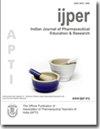Mucoadhesive Chitosan-Coated PLGA Nanoparticles of Ashwagandha Extract for Colon-Targeted Delivery
IF 0.8
4区 医学
Q3 EDUCATION, SCIENTIFIC DISCIPLINES
Indian Journal of Pharmaceutical Education and Research
Pub Date : 2023-10-04
DOI:10.5530/ijper.57.4.119
引用次数: 0
Abstract
Abstract: Aim/Background: Withania somnifera (Ashwagandha) belongs to the Solanaceae family, well known for its phyto-pharmacological properties such as anti-inflammatory, antioxidant, anti-stress, immunomodulatory, and anticancer properties. The study aimed to formulate and evaluate chitosan-coated PLGA nanoparticles of ashwagandha extract. The nanoparticle formulation technique was considered in order to rectify the various constraints associated with ashwagandhas, such as intestinal absorption, burst release of the drug, and bioavailability issues. Materials and Methods: The CS-PLGA NPs were prepared by single-emulsion solvent evaporation method and it was optimized by using the Box-Behnken design in Design-Expert Software to determine the influence of independent variables PLGA, chitosan concentration and sonication time on particle size. PDI and entrapment efficiency. Results: The particle size, PDI, and zeta potential of the optimized formulation were found to be 187.1nm, 0.148, and 31.3mV. Optical microscopy and SEM suggest that the particles were smooth, spherical, and uniform in size. The entrapment efficiency of the optimized formulation was found to be 84.28%. In vitro drug release study suggests that the enteric coating of the CS-PLGA NPs formulation prevented the drug release in SGF and showed sustained drug release than pure ashwagandha and the drug release kinetics followed the Korsmeyer-Peppas model. Furthermore, the CS-PLGA NPs were evaluated for in vitro antioxidant activity over DPPH, and in vitro cytotoxicity assay over CaCo-2 cell lines. The results showed enhanced antioxidant activity than pure ashwagandha and better cytotoxicity over CaCO-2 cells. Conclusion: The studies concluded that CS-PLGA NPs showed sustained drug release for a prolonged period. The formulation showed good antioxidant activity and better efficacy in cancer cells. Keywords: Ashwagandha, Nanoparticles, Chitosan, PLGA, Anti-cancer activity.黏附壳聚糖包被的印度人参提取物的PLGA纳米颗粒结肠靶向递送
摘要:目的/背景:Withania somnifera (Ashwagandha)属于茄科植物,具有抗炎、抗氧化、抗应激、免疫调节和抗癌等植物药理作用。本研究旨在制备并评价ashwagandha提取物壳聚糖包被PLGA纳米颗粒。纳米颗粒配方技术被认为是为了纠正与ashwagandhas相关的各种限制,如肠道吸收,药物的爆发释放和生物利用度问题。材料与方法:采用单乳液溶剂蒸发法制备CS-PLGA NPs,并在design - expert软件中采用Box-Behnken设计对其进行优化,考察PLGA、壳聚糖浓度、超声时间等自变量对粒径的影响。PDI和捕集效率。结果:优化后的配方粒径为187.1nm, PDI为0.148,zeta电位为31.3mV。光学显微镜和扫描电镜显示,颗粒光滑,球形,大小均匀。优化后的包封率为84.28%。体外释药研究表明,CS-PLGA NPs制剂的肠内包衣阻止了药物在SGF中的释放,且药物释放比纯ashwagandha持续,药物释放动力学符合Korsmeyer-Peppas模型。此外,研究了CS-PLGA NPs对DPPH的体外抗氧化活性,并对CaCo-2细胞系进行了体外细胞毒性试验。结果表明,与纯ashwagandha相比,ashwagandha具有更强的抗氧化活性,并且对CaCO-2细胞具有更好的细胞毒性。结论:CS-PLGA NPs具有较长时间的持续释药作用。该制剂具有良好的抗氧化活性,对肿瘤细胞有较好的抑制作用。关键词:Ashwagandha,纳米颗粒,壳聚糖,PLGA,抗癌活性
本文章由计算机程序翻译,如有差异,请以英文原文为准。
求助全文
约1分钟内获得全文
求助全文
来源期刊
CiteScore
1.40
自引率
0.00%
发文量
227
审稿时长
>12 weeks
期刊介绍:
The official journal of Association of Pharmaceutical Teachers of India (APTI) and is being published since 1967. IJPER, a quarterly publication devoted to publish reviews and research articles in pharmacy and the related disciplines of Pharmaceutical education. It mainly covers the articles of special interest, covering the areas of Pharmaceutical research, teaching and learning, laboratory innovations, education technology, curriculum design, examination reforms, training and other related issues. It encourages debates and discussions on the issues of vital importance to Pharmaceutical education and research. The goal of the journal is to provide the quality publications and publish most important research and review articles in the field of drug development and pharmaceutical education. It is circulated and referred by more than 6000 teachers, 40,000 students and over 1000 professionals working in Pharmaceutical industries, Regulatory departments, hospitals etc.

 求助内容:
求助内容: 应助结果提醒方式:
应助结果提醒方式:


